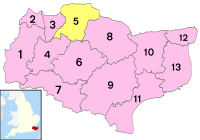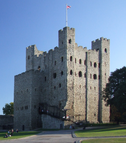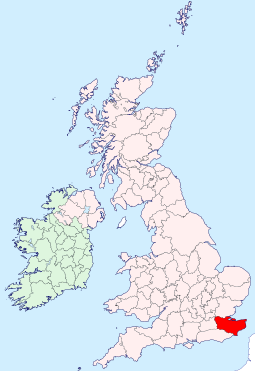
Back Kent Afrikaans كنت Arabic كينت ARZ Kent AST Kent Azerbaijani Kent BAN Кент Byelorussian Кент BE-X-OLD Кент Bulgarian Kontelezh Kent Breton
Kent | |
|---|---|
The White Cliffs of Dover, stained glass depicting Thomas Becket in Canterbury Cathedral, and Rochester Castle | |
| Coordinates: 51°12′N 0°42′E / 51.200°N 0.700°E | |
| Sovereign state | United Kingdom |
| Constituent country | England |
| Region | South East |
| Established | Ancient |
| Time zone | UTC+0 (GMT) |
| • Summer (DST) | UTC+1 (BST) |
| UK Parliament | List of MPs |
| Police | Kent Police |
| Ceremonial county | |
| Lord Lieutenant | Annabel Campbell, the Lady Colgrain |
| High Sheriff | Mrs Remony Millwater[1] (2020/21) |
| Area | 3,738 km2 (1,443 sq mi) |
| • Rank | 10th of 48 |
| Population (2022)[2] | 1,875,893 |
| • Rank | 7th of 48 |
| Density | 502/km2 (1,300/sq mi) |
| Ethnicity | 93.7% White (89.1% White British)[3] |
| Non-metropolitan county | |
| County council | Kent County Council |
| Control | Conservative |
| Admin HQ | Maidstone |
| Area | 3,544 km2 (1,368 sq mi) |
| • Rank | 6th of 21 |
| Population (2022)[4] | 1,593,191 |
| • Rank | 1st of 21 |
| Density | 449/km2 (1,160/sq mi) |
| ISO 3166-2 | GB-KEN |
| GSS code | E10000016 |
| ITL | UKJ42 |
| Website | kent |
| Districts | |
 Districts of Kent Unitary County council area | |
| Districts | |
Kent is a county in the South East England region, the closest county to continental Europe. It borders Essex across the entire estuary of the River Thames to the north; the French department of Pas-de-Calais across the Strait of Dover to the south-east; East Sussex to the south-west; Surrey to the west and Greater London to the north-west. The county town is Maidstone.
It is the fifth most populous county in England, the most populous non-metropolitan county and the most populous of the Home Counties, an area influenced by the capital such as commutes and transport connections to the capital. Twenty-eight per cent of the county forms part of two Areas of Outstanding Natural Beauty: the North Downs and The High Weald.
Kent was one of the first British territories to be settled by Germanic tribes, most notably the Jutes, following the withdrawal of the Romans.[5] Canterbury Cathedral in Kent, the oldest cathedral in England, has been the seat of the Archbishops of Canterbury since the conversion of England to Christianity that began in the 6th century with Saint Augustine. Rochester Cathedral in Medway is England's second-oldest cathedral. Located between London and the Strait of Dover, which separates England from mainland Europe, Kent has been the setting for both conflict and diplomacy, including the Battle of Britain in World War II and the Leeds Castle peace talks of 1978 and 2004.
England relied on the county's ports to provide warships through much of its history; the Cinque Ports in the 10th[6]–14th centuries and Chatham Dockyard in the 16th–20th centuries were of particular importance. France can be seen clearly in fine weather from Folkestone and the White Cliffs of Dover. Hills in the form of the North Downs and the Greensand Ridge span the length of the county and in the Vale of Holmesdale in between and to the south are most of the county's 26 castles.
The county has agriculture, haulage, logistics and tourism industries. As the land between the capital and the wider continent, it is a high-income county. Agriculture of the county is a notable sector: "The Garden of England" is a nickname for the county, which has multiple orchards and allotments.[7] In north-west Kent, industries include aggregate building material extraction, printing and scientific research. Coal mining has also played its part in the county's industrial heritage.
- ^ "No. 62943". The London Gazette. 13 March 2020. p. 5161.
- ^ "Mid-2022 population estimates by Lieutenancy areas (as at 1997) for England and Wales". Office for National Statistics. 24 June 2024. Retrieved 26 June 2024.
- ^ "2011 Census: Cultural diversity in Kent" (PDF). Kent City Council. Archived (PDF) from the original on 5 November 2021. Retrieved 18 October 2021.
- ^ "Mid-Year Population Estimates, UK, June 2022". Office for National Statistics. 26 March 2024. Retrieved 3 May 2024.
- ^ "Kent | county, England, United Kingdom". Encyclopedia Britannica. Archived from the original on 22 April 2018. Retrieved 1 January 2020.
- ^ G. O. Sayles, The Medieval Foundations of England (London 1967). p. 186.
- ^ Wainwright, Martin (1 June 2006). "Kent loses its Garden of England title to North Yorkshire". The Guardian. ISSN 0261-3077. Archived from the original on 13 January 2022. Retrieved 28 May 2023.




